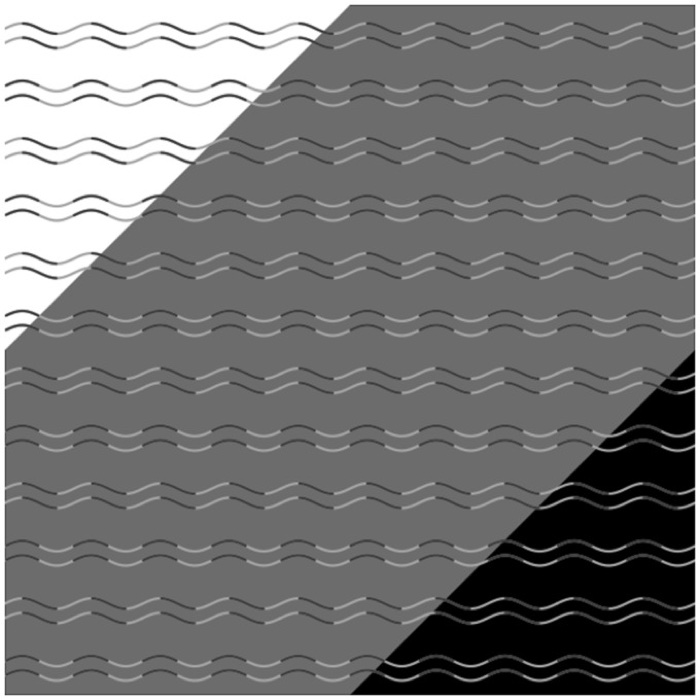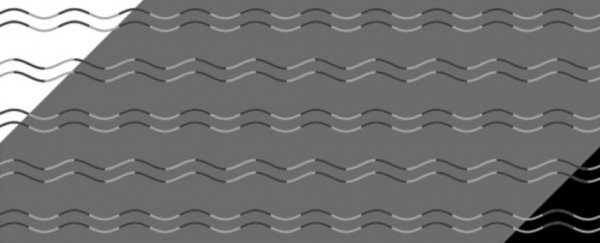Everybody loves a good optical illusion - and this trippy perception trick has us questioning how we see the world around us.
Take a look at those lines in the image above (or you can see the full picture below if you scroll down a bit). What kind of lines do you see? Are they straight, edgy zigzags, or soft, curvy waves? Do you see just one kind, or both?
This optical illusion, discovered by experimental psychologist Kohske Takahashi from Japan's Chukyo University in 2017, is called the 'curvature blindness illusion', and it's just another example of how we can't always trust our eyes when we're looking right at something.
If you're like most people, you'll probably see both wavy lines and zigzag lines in alternating pairs – at least, you will if you're staring at the lines in front of the grey background that dominates the middle of the picture:
 (Kohske Takahashi/i-Perception)
(Kohske Takahashi/i-Perception)
But now, take a look at the lines in the top-left and bottom-right areas of the image, where the backdrop is either white or black. Notice anything different going on?
If the lines in those black/white areas look wavy to you but you're also seeing zigzag lines in the grey middle section, congratulations: you've just been diagnosed with curvature blindness! (Don't worry, it's not an actual medical condition or anything.)
But why do so many of us see zigzag lines in the picture, when in actuality every line in the image is wavy?
According to Takahashi, it could be to do with how our eyes differentiate curves and corners in the real world – and it's possible the way we tell the two apart triggers some kind of conflict in the brain's visual system.
"We propose that the underlying mechanisms for the gentle curve perception and those of obtuse corner perception are competing with each other in an imbalanced way," Takahashi explains in his paper, "and the percepts of corner might be dominant in the visual system."
But why do corners trump curves instead of the other way around? Hypothetically speaking, it could be because of how humans have had to accommodate the contrived geometries of the modern physical world around us.
"I'd say that our eyes and brain may have been evolutionarily adapted to detect corners more efficiently than curves," Takahashi told The Telegraph.
"We are surrounded by artificial products, which have much more corners than [the] natural environment does, and hence our visual. This visual phenomenon doesn't cause the problem in our everyday life, otherwise someone should have found this illusion earlier."
In terms of how the illusion actually tricks our eyes, Takahashi ran a series of experiments with participants and slightly altered images to see what the optimal conditions were to trigger the illusion.
In the picture seen here, the contrast in brightness between the different sections making up the lines and the background shade is reversed at the turning points.
If you look closely, you'll notice that the 'zigzag' lines are made up of light and dark grey that runs from the peak to the valley of each curve. This accentuates the illusion that those sections of the wave are straight lines slanted either upwards or downwards, rather than isolated sections of a continuous wave.
By contrast, on the 'wavy' lines (and remember, they're all actually wavy), the alternate light and dark grey colourings envelop the peaks and valleys, which helps accentuate the curves.
Another factor that helps the illusion work is the relative shallowness of the wave, with gentle, low curves – whereas a steeper wave with sharper angles disrupts the effect.
If you like that one, make sure to check out these mind-melting optical illusions too, including the case of the amazing invisible black dots, and how squares are sometimes circles.
And who could forget that dress?
The findings are reported in i-Perception.
A version of this article was first published in December 2017.
